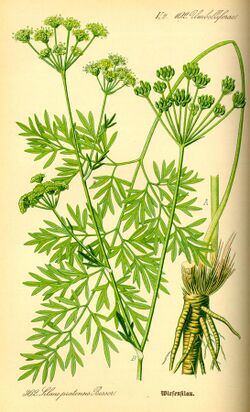Biology:Silaum
| Silaum | |
|---|---|

| |
| A botanical illustration of Silaum silaus | |
| Scientific classification | |
| Kingdom: | Plantae |
| Clade: | Tracheophytes |
| Clade: | Angiosperms |
| Clade: | Eudicots |
| Clade: | Asterids |
| Order: | Apiales |
| Family: | Apiaceae |
| Subfamily: | Apioideae |
| Genus: | Silaum Mill. |
Silaum is a genus of flowering plants in the carrot/parsley family, Apiaceae. There are currently ten species placed into the genus, a list of which is provided below.[1]
Description
Plants in the genus Silaum have umbels which are characteristic of plants in the family Apiaceae (they are umbelliferous, "umbel-bearing"); the umbels in Silaus species tend to lack bracts.[2] Silaum species also tend to have a few umbellules (secondary umbels of compound umbels), and these umbellules have several small bracts called bractlets.[2] Remains of dead leaves can often be found at the base of the plant; plants in Silaum are richly branched.[2]
The fruits of Silaum species have a carpophore,[2] a supporting slender stalk for each half of a gape or burst open (dehisced) fruit[3] - these are common throughout the family Apiaceae; the carpophore is thread or filament-shaped (filiform).[2] In addition, Silaum fruits are elongated, divided and not flattened.[2] The mericarps (one carpel of umbelliferous fruit)[4] have acute edges and five, rather low ridges.[2] Plants in Silaus also have an oil tube in the fruit, called a vitta[2][5] - there is one vitta per every ridge of furrow (a vallecula), but are indistinct at maturity.[2] The petals that surround the flowers are yellow.[2]
Taxonomy and naming
Silaum was first formally described in 1754 by the Scottish botanist in charge of the Chelsea Physic Garden, Philip Miller; this description was published in his own reference series, The Gardeners Dictionary (abr., ed. 4 (1754)).[2] The etymology of Silaum was not explicitly offered by Miller, who applied a plant name used by Pliny,[6] though it may refer to the mountainous plateau La Sila in southern Italy.[7]
Species
The Global Biodiversity Information Facility (GBIF) lists ten species that are currently placed in the genus Silaum:[1]
- Silaum besseri (DC.) Galushko
- Silaum foliosum (Sommier & Levier) Grossh.
- Silaum perfoliatum (Pharm. ex Wehmer) M.Hiroe
- Silaum peucedanoides (M.Bieb.) M.Hiroe
- Silaum popovii (Korovin) M.Hiroe
- Silaum saxatilis Bajtenov
- Silaum serotinum (Pers.) M.Hiroe
- Silaum silaus (L.) Schinz & Thell.
- Silaum tenellum (Velen.) M.Hiroe
- Silaum tenuifolium (Poir.) Reduron
References
- ↑ 1.0 1.1 "Silaum Mill.". GBIF Backbone Taxonomy. GBIF.org. Archived from the original on 28 December 2013. https://web.archive.org/web/20131228101638/http://www.gbif.org/species/6027385. Retrieved 27 December 2013.
- ↑ 2.00 2.01 2.02 2.03 2.04 2.05 2.06 2.07 2.08 2.09 2.10 Fröberg, Lars. "Silaum". Apiaceae for Flora Nordica. Flora Nordica. Archived from the original on 29 October 2013. https://web.archive.org/web/20131029200225/http://www.floranordica.org/Review/-Review_public/accounts/Silaum.html. Retrieved 27 December 2013.
- ↑ "definition of carpophore". TheFreeDictionary.com. http://www.thefreedictionary.com/carpophore. Retrieved 30 December 2013.
- ↑ "definition of Mericarp". TheFreeDictionary.com. http://www.thefreedictionary.com/Mericarp. Retrieved 30 December 2013.
- ↑ "definition of vitta". TheFreeDictionary.com. http://www.thefreedictionary.com/vitta. Retrieved 30 December 2013.
- ↑ Pliny the Elder, Naturalis Historia, Book XXVI, chapter lvi, § 88, the sole mention of Silaus: silaus nascitur glariosis et perennibus rivis, cubitalis apii similitudine...
- ↑ Gledhill, D. (2008). The Names of Plants (4 ed.). Cambridge University Press. pp. 353–. ISBN 9780521866453. https://books.google.com/books?id=NJ6PyhVuecwC&pg=PA353. Retrieved 29 October 2013.
Wikidata ☰ Q743050 entry
 |

